A few months ago my dad and I were interviewed about the farm and how we came to be. Here’s the whole article for you to read!
If you’re loving this article, then why not look at signing up to a monthly subscription?

A few months ago my dad and I were interviewed about the farm and how we came to be. Here’s the whole article for you to read!


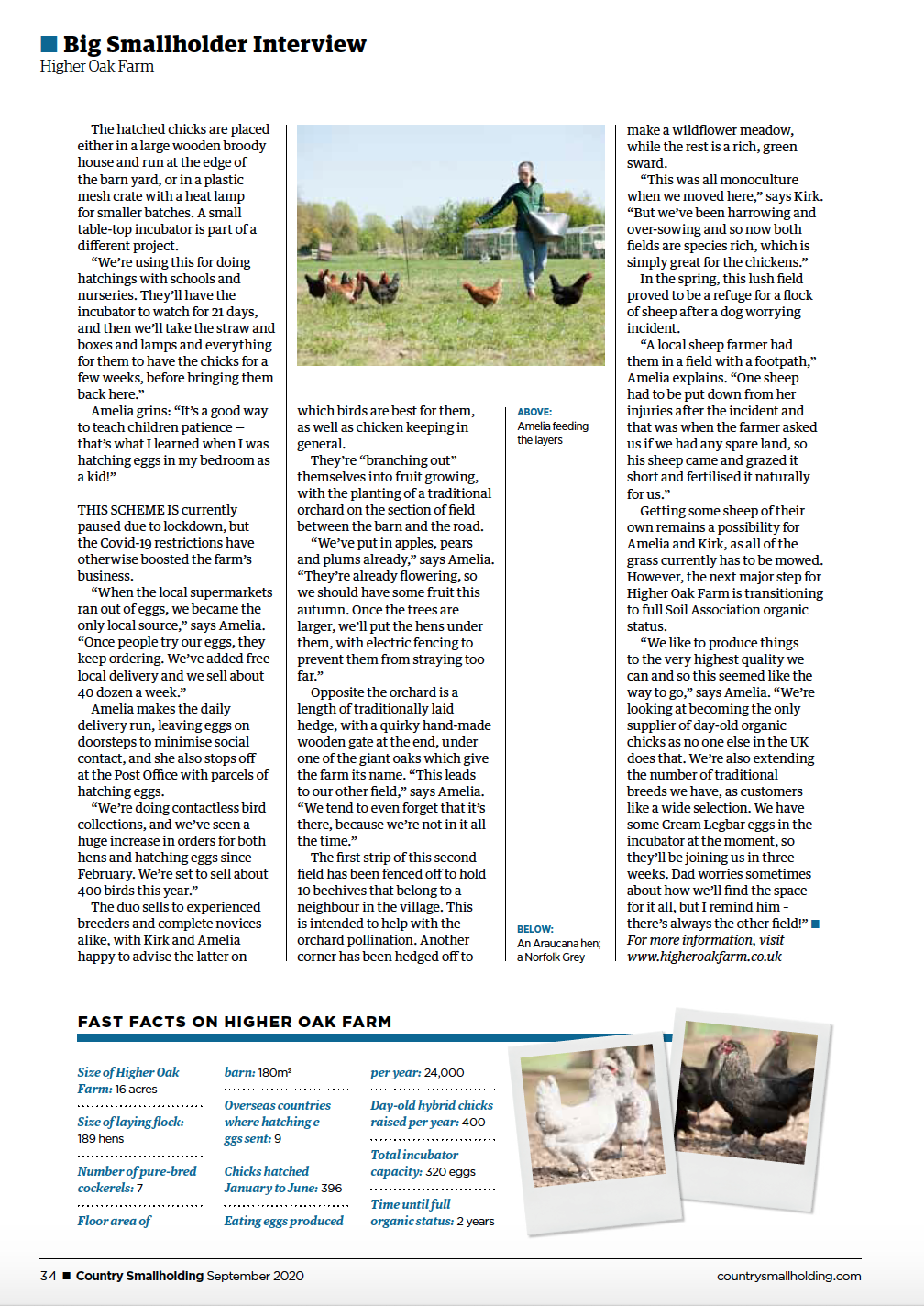
If you’re loving this article, then why not look at signing up to a monthly subscription?
If you’ve had hens before, you’ll know that occasionally your ladies can lay some weird looking eggs! This blog is to help you understand why your hens are producing abnormal eggs.
Double Yolkers.
These are such an amazing find! There’s nothing better than cracking open your egg to find 2 yolks. This can happen when an existing yolk combines with another and the shell forms around both. It’s a hens version of twins. Young pullets and older hens tend to lay these are their egg cycles are just beginning or coming to the end.

Super Tiny Eggs.
Also known as wind, fairy or fart eggs, tiny eggs can be a sign that your hen has just started to lay or that something might be wrong with their production system if they keep laying them. If they are constant, ensure you speak to your vet.
You should always consider the age of the hen if you experience any of the below:
Thin Shelled Eggs
This is usually a sign that your hen needs a bit more calcium in their diet. You can add this in by providing them with Oyster Shell. The hen will then ingest as much as she needs.
Bumpy Eggs
These are abnormal for both young and older hens. This can be caused by excess Vitamin D or Vitamin C in the hens diet.
Very Large Eggs
These tend to be laid by hens coming to the end of their laying cycle.

Stress, Diet or Disease can cause the below abnormalities:
Shell-less or Thin Shelled-Eggs
These are normally due to stress, which causes the eggs to be laid before it’s been completely formed.
Wrinkled Eggs
These are funky looking and can be induced by rough handling of your hens, causing a second yolk to be prematurely released and bumping up against the egg, causing the wrinkles. Another factor that can cause wrinkling is a respiratory infection in the hens.
Eggs with Healed Cracks
These start with a break in the shell during formation but mend during the laying process. The hen experiencing stress during the calcification is the main culprit for this type of egg.
Egg In An Egg
This happens when an egg gets backed up and not laid in a timely manner. The egg actually goes through the last production stages twice. Extreme stress to your poor hen is probably the reason. She may need a spa day complete with a dust bath and mealworms to nibble on.
If you find that you’re experiencing any of the above and have tried to fix the issue but had no luck, make sure to contact your vet to make sure your lovely lady is ok!
If you follow us on social media, you may have seen our photos of all our beautiful coloured eggs. We have so many people asking us who lays which eggs as they’d love to source some of their own.
A little more info on coloured eggs:
The colour of the shell is down to the genetics of the chicken itself. One hen will lay the same coloured egg throughout her lifetime, although the hue may darken as she gets older and comes to the end of her egg laying cycle.
Even though the colour of the shell differs on the outside, on pretty much all colours, the inside of the shell is white. This isn’t the case with blue eggs though, these are blue all the way through! The colour of the egg doesn’t change the nutrients of the eggs and will all taste the same providing they are all on the same feed in the same environment.
How does a hen lay a coloured egg?
The journey of an egg through the hens oviduct takes approximately 26 hours, the shell takes about 20 of those hours to be complete! Hens that lay the blue eggs have the pigment oocyanin deposited on the egg as it travels through the oviduct. This pigment permeates the shell which enable to shell to be blue all the way through. Hens that lay any other colour of egg deposits the pigment protoporphyrin on the eggs much later in the process which stops it permeating the whole shell, therefore leaving the shell white inside.

So who lays which colour?
Blue Eggs -
Our eggs are laid by our Araucana Hens. The Araucana on the farm originated from other members of the British Araucana club. We keep all the best birds in small breeding flocks of up to 10 hens with one cock. We hatch all our stock on the farm for each new season. The best birds are kept to improve the breed standard and other birds go into our laying flock for their lovely blue eggs.

We also have a new hybrid to the farm called Cream Legbars. They are a cross between a Plymouth Barred Rock, a Golden Leghorn and an Araucana. It was developed in Great Britain as an auto sexing breed, the ability to easily distinguish between a cockerel and a hen as soon as they hatch.
Green Eggs-
Our green eggs are laid by a breed that we created on the farm. We crossed an Araucana Cockerel with a Copper Comet Hen. The genetics of the araucana which lays the blue egg crossed with the genetics of the Copper Comet which lays a dark brown egg creates a hen which lays an olive coloured egg. A lot of people refer to them as ‘Olive Eggers’. We’re calling ours the Hi-Oak Olives.

Dark Brown Eggs-
Our really dark brown eggs are laid by a hybrid Maran hen called a Copper Comet. These very attractive hens have black plumage with gold markings on the neck and chest. The amount of markings will vary from hen to hen within the breed. The iridescent black feathers have a stunning green sheen in the sunlight.
They are very calm hens who will reward you with lots of lovely eggs. They are very hardy and will want to be outside in all weather.

White Eggs-
Our white eggs are laid by our Silver Spangled Hamburgs. The Hamburgs on our farm originated, a number of years ago, from the eggs of a well know exhibitor and judge Ian Allonby. We have a small breeding flock and we hatch all our stock on the farm for each new season. They are one of our most popular breeds for hatching eggs and pullet sales but are very limited in their availability.

We also have our Old English Pheasant Fowl that lay a white egg. The OEPF on our farm are one of the first rare breeds that we brought to the farm. I was interested in a breed that is local to our area and was kept by my grandparents on their farm in Lancashire in the early 1900’s. It’s so long ago I can’t remember who I bought the original hatching eggs from. I have over the years introduced a couple of different cock birds, from other specialist breeders, to keep the line fresh. We have a breeding flock of about 10 birds and a number of others in the laying flock. We hatch all our stock on the farm for each new season.
As well as our rare breeds, we also have our Hi-Oak White hens that lay a large, white egg.The Hi-Oak White is a hybrid hen bought in as day-old chicks from the Hendrix Genetics. We raise these birds in exactly the same environment as our rare breeds to Organic standards. They begin to lay at around 19-20 weeks old and have a superb shell quality. These hens are adaptable to all types of housing systems, they are very docile and equally happy free ranging or in a small coop.
Brown/Tinted Eggs-
Our tinted eggs are laid by a few different breeds:
One of our rare breeds that lays a tinted eggs is the Norfolk Grey. The Norfolk greys on our farm are all originated from some hatching eggs I bought about 10 years ago. We have a breeding flock of about 10 birds and a number of others in the laying flock. We hatch all our stock on the farm for each new season.

Another of our rare breeds is the Light Sussex. Both hens and cocks are large, well-built and very friendly. Our breeding stock originates mainly from the retirement sale of Nick Smith’s flock (Nick Smith, from Herefordshire is a legendary breeder of the light Sussex). The Cock birds on the farm are large and very strong birds fortunately they are easily handled and can be quite tame.
We’ve also got two hybrids that lay a tinted egg. The Hi-Oak Brown is a hybrid hen bought in as day-old chicks from either the Hy-line or Joice & hill hatcheries. We raise these birds in exactly the same environment as our rare breeds. It is one of the world’s best brown egg layers. They begin to lay around 19-20 weeks old and starts to lay with some of the largest size pullet eggs we’ve ever seen. The birds have been brought up outdoors from an early age and they are fully hardened to our weather in the North of England. They are great free rangers but are equally happy in a small coop.
The Muirfield Black Rock is a hybrid hen bought in as day-old chicks from the Crosslee Farm in Scotland. We raise these birds in exactly the same environment as our rare breeds. She begins to lay brown tinted eggs at around 20-22 weeks. Having been brought up outside and bred specifically for the outdoors they are fully hardened to our weather in the north of England are equally happy in a small coop or free ranging.
If you’re looking to add some different colours into your eggs basket, just get in contact and we’ll let you know our availability!
Since working on the farm, i’ve become accustomed to the chicken ‘slang’ that so many breeders and poultry experts use in their everyday lives. I, being a designer, had absolutely no clue what they were on about. I spent a lot of time googling, so for anyone who is in the same situation that I was in 6 months ago, i’ve made it easier for you. Below is a list of words that are used everyday in the world of chickens.

Hatchery - A company that specialises in hatching chicks and providing the farms with the day old chicks.
Pullet - A female chicken that’s not quite a chick and not yet laying eggs. They are the chicken equivalent to a teenager.
Chick - A baby chicken.
Cockerel/ Rooster/ Cock - A male chicken.
Hen - A female chicken that is old enough to lay.
Bantam - A smaller version of different breeds. They are normally about 1/2 the size of ‘large fowl’ chickens.
Production Layer - Chicken breeds that lay an abundance of eggs consistently. Normally used on egg farms.
Broiler - A chicken that’s been bred for meat and no egg production.
Layers - Hens that are laying eggs.
Straight Run - A batch of chicks that is unsexed and contains both male and female birds.
Sexed - When the sex has been determined on the birds.
Chicken Anatomy:
Shaft - The hard thing that the feathers grow out of.
Comb - The red/pink fleshy bits that sits on the birds beak and forehead.
Vent - The omni-hole that chicken poo and the eggs come out of.
Gizzard - A hard muscular stomach that grinds down food.
Crop - An organ in the chest that stores food to be processed by the gizzard.
Leg Scales - The dinosaur like scales on the hens legs down to your chickens feet.
Spur - The big scary nail that sticks out of a cockerels leg. They are used as daggers when fighting.
Wattle - The things that dangle down from your chickens beak.
Hackles - The feathers on the neck that are raised when the bird is getting ready to fight.
Saddle Feathers - The long, lovely feathers around the cockerels bum.
Chick tooth - chicks are born with this on their beaks to help them break through the shells. It’ll drop off in time.
Down - the super fluff that a chick is born with
Chicken Health Terminology:
Mite - Insects that live in the coop and feast on the hens, they are a blood sucking insect and can be a real nuisance to your girls.
Coccidosis - Super horrible parasite in the digestive tract, can be fatal to the birds.
Marek’s Disease - A virus that can cause a chickens eyes to change colour, can cause paralysis and lesions.
Bumblefoot - An infection on the bottom of a chickens foot.
Egg Bound - When a hen has trouble getting her egg out and it gets stuck.
Dust Bath - This is how your chickens keep themselves clean, they roll around in the dirt and flap their wings about.
Molt - Chicken shed some of their feathers and grow new ones.
New Castles Disease - A Contagious poultry virus that can be passed onto humans.
Diatomaceous Earth (DE) - This is a super dust that is great for dust baths and treating chickens for parasites.
Hopefully these definitions will help you understand ‘chicken people’ a little bit more!
We’ve all had a few times when we’ve gone into the coop to collect the eggs and they’ve disappeared, with only a wet bit of sawdust to be found. Well chances are, either you’ve got some pests visiting your coop or you’ve got a hungry hen!

What makes hens eat their own eggs?
An egg that’s been laid in nesting box can sometimes be broken by a heavy footed lady. If that is the case, they’ll take advantage and eat the whole lot. This is not a good habit for them to get in to!
Boredom can also be a factor, especially during winter when hens spend more time inside the coop. Chickens are naturally curious, so any new ‘toy’ will become an obsession.
The nesting box size could also be causing the issue. If there isn’t ample space for the hens to lay then they can jostle and fight to get into the boxes. This can break the eggs that have already been laid and they’ll munch on them.
Nutrition can also be a factor. If the hens are lacking in calcium or protein, the hens will seek out food sources where ever they can. Since the eggs are readily available, they are the first thing to go!
How do I save my eggs?!
If you remove the eggs at least twice a day it means that the hens have less time to seize their opportunity and eat the egg. You can also get a nesting box that allows the eggs to roll away to ensure they can’t reach the egg! Below is how our nesting boxes work.
You can also make sure you have an ample supply of nesting material in the boxes, giving a soft, squishy layer means that there is less chance of breakage. If an egg does happen to break, make sure you remove all eggy nesting material and replace it with clean bedding.
Make sure that you have plenty of room in your coop and some toys to keep them entertained and hopefully leave your eggs alone!
Make sure that your flock have the correct diet and nutrients that they need so they don’t look for it elsewhere. We also give our hens an extra container filled with Oyster shell to help fulfil their calcium and grit needs.
Taking these few extra steps should help reduce the egg eating and help increase the happiness and healthiness of your flock!
In February we were featured in the ‘Landscape Magazine’. We were interviewed about our experience with the Light Sussex breed. We’ve finally got the article that was featured in the magazine so i’ve popped it below for you to have a read!


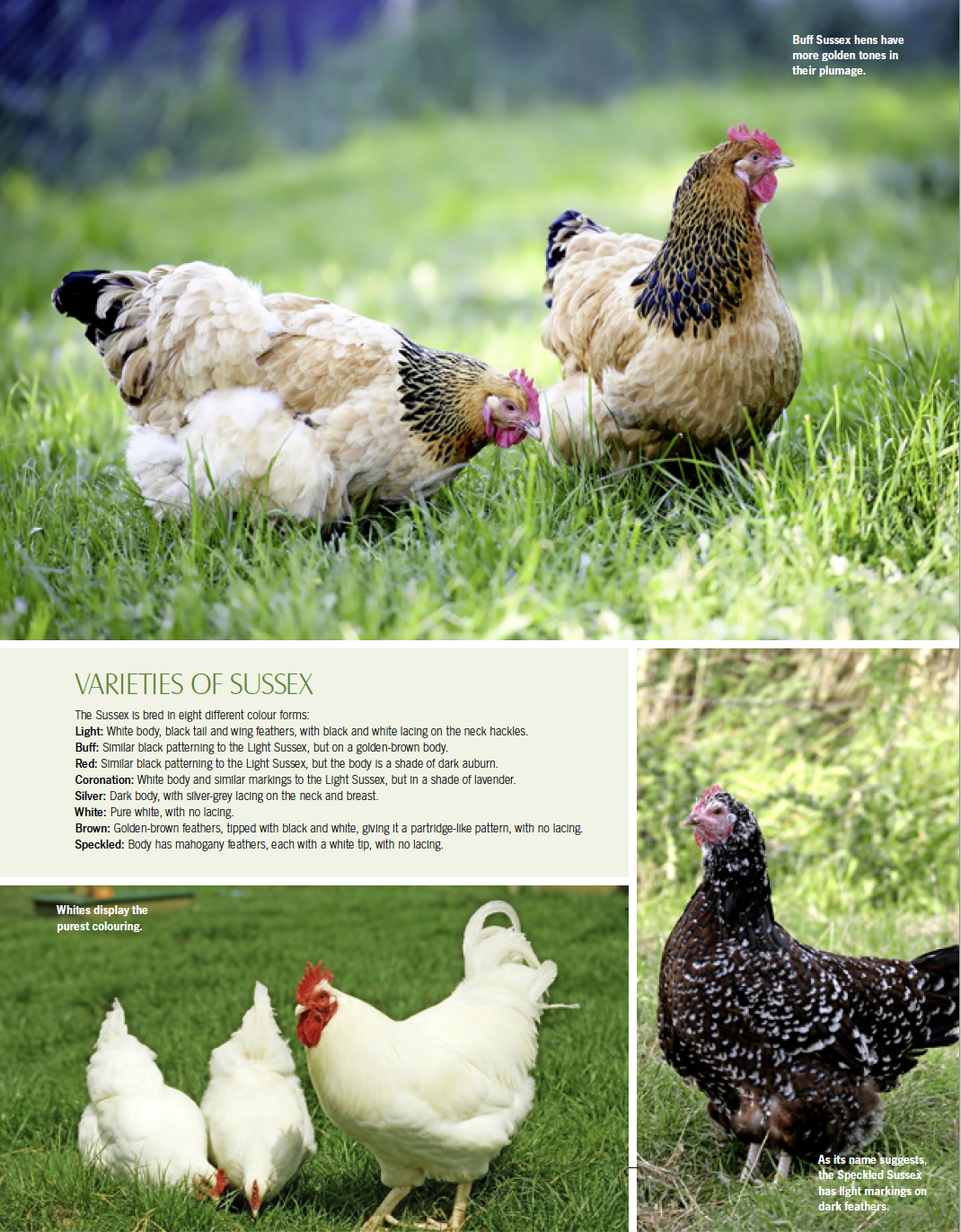
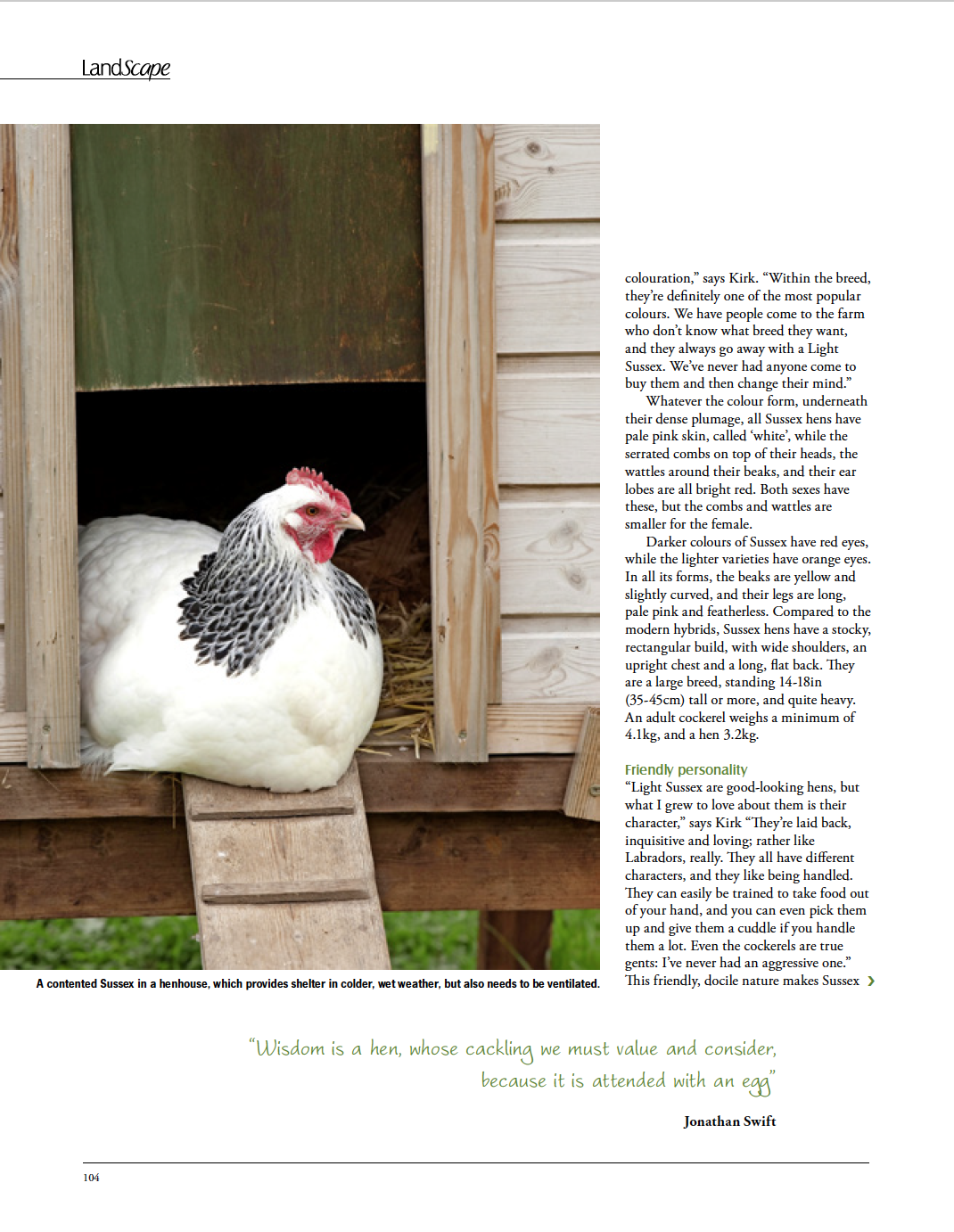
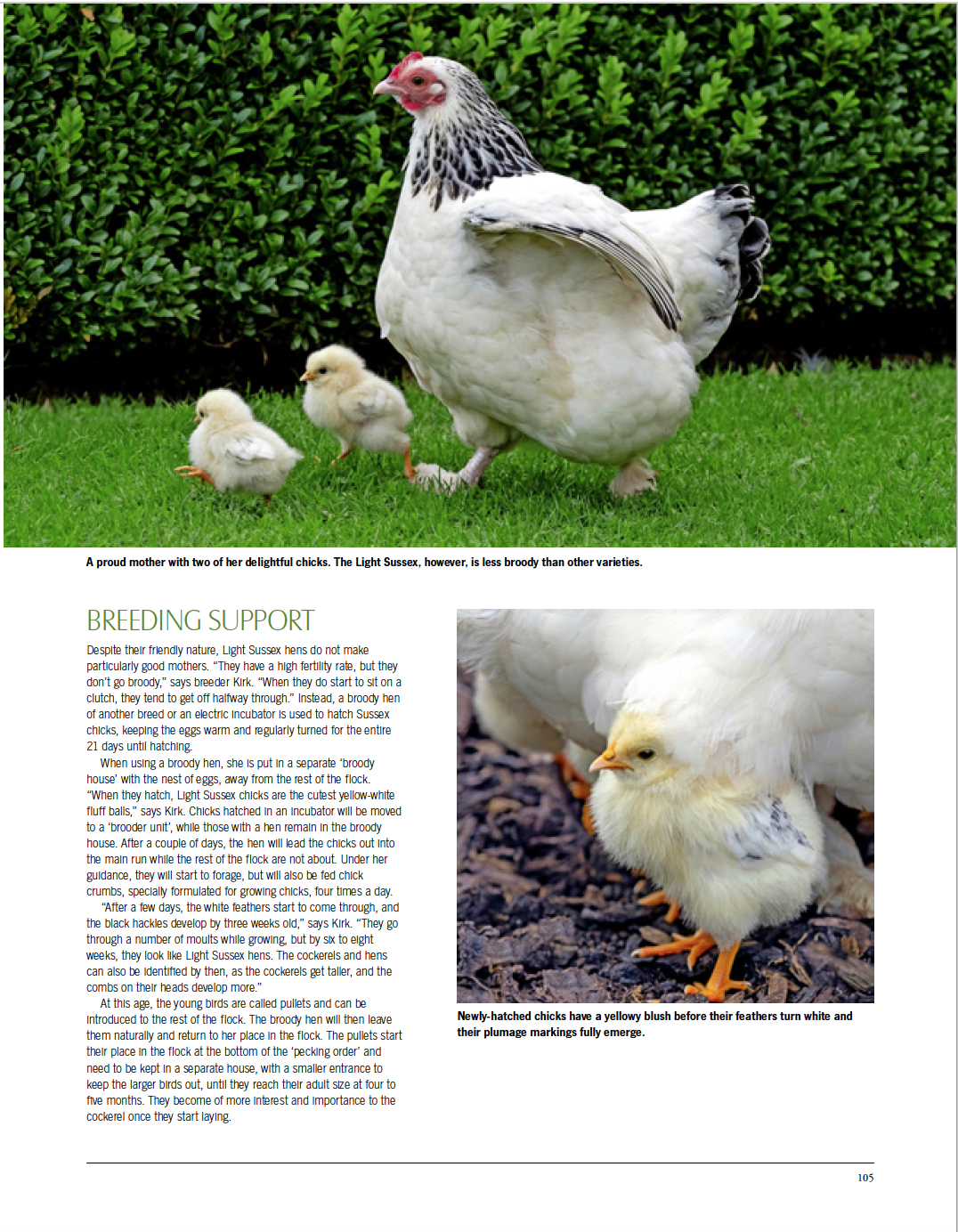

If you’d like to find out a bit more about the Landscape Magazine, have a look on the link below!
In the UK it’s actually illegal to feed your hens any kitchen scraps! In the good old days, they were a perfect output for all the bits of vegetables that were left after the Sunday roast. However, nowadays there’s nothing stopping you from giving your hens the extra bits of veg straight from the garden. We often feed our hens the grapes and extra bits of vine off our grape vine when we trim it and they go nuts for them!

We’ve had a few people ask us what the definitely shouldn’t feed their hens, so thought i’d let you guys know what’s actually poisonous to them:
Avacadoes:
The peel and pit of an avocado contains persin which can be toxic to birds. So definitely steer clear of this one! The fleshy part is ok to feed them in moderation.
Chocolate
Normally speaking people wouldn’t necessarily think to feed chocolate to their hens, but if you ever thought about it, don’t! the compound that is toxic to dogs, Theobromine, is also toxic to birds.
Potato Plants
Green potatoes contain Solanine which is another substance that is toxic to birds, don’t give them sprouted potatoes either as they have the same toxin. It’s bad for their nervous system. The leaves and stems are also toxic so keep them away from the plants too.
Dried beans
Dried beans contain hemaglutin which is toxic to birds.
Moldy or rotten food
Stale or overripe food is fine for the hens, but don’t give them moldy food, it’ll upset their tummies and they could get bacteria from the food.
Tomato, Pepper or Aubergine leaves
As members of the nightshade family they contain Solanine, but they can eat the produce, just not the leaves!
Rhubarb leaves
They contain Oxalic Acid which can cause calcium deficiency in the hens. Prolonged exposure can lead to kidney failure.
Raw Eggs
These are actually ok for the hens to eat, but if they get wind of how tasty they are, then you might experience them eating them straight out of their nest boxes! Not ideal for you.
Onions, Chives and garlic
A small amount is fine, but too much can alter the flavour of the eggs! Too much can also cause them to develop Heinz Anemia.
Raw Meat
It can carry pesticides and disease. It can potentially lead to aggressive behaviour and cannibalism within the flock.
Dairy
Chickens aren’t able to digest lactose so it’s best to avoid anything dairy. If you want to increase their calcium, just feed them crushed up egg shell.
Grass clippings and pulled weeds
Eating bits that are too big can lead to an impacted crop so it’s best to just let them forage for themselves.
It may seem like a lot that they can’t have, but there’s so much that they can have, so don’t feel put off by this list, it’s just a helping hand to ensure you give the hens the correct foods!
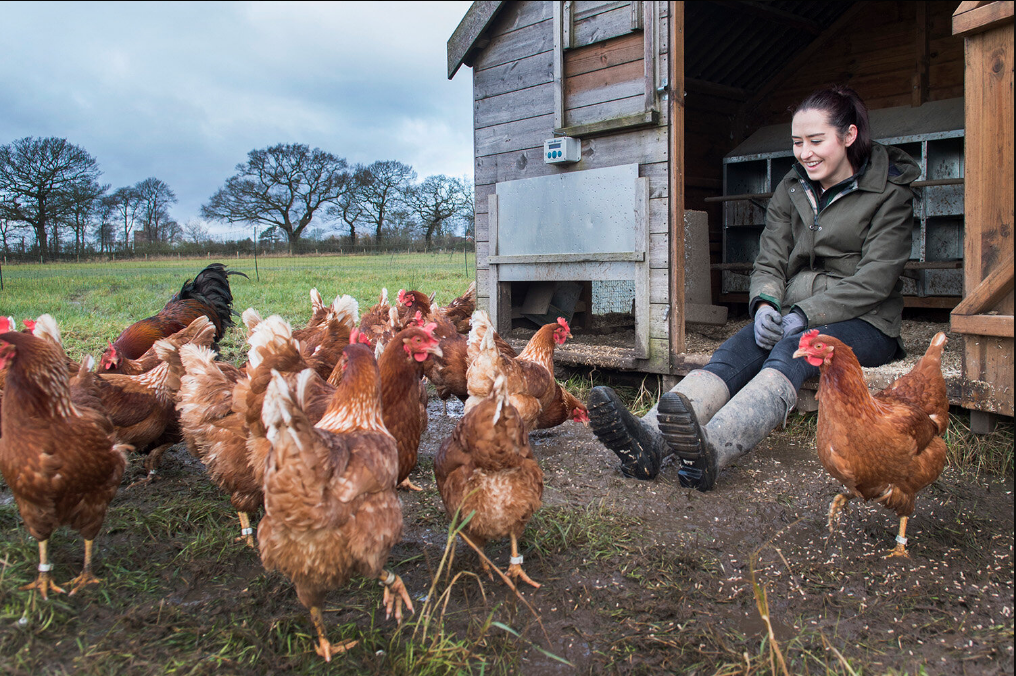
I see so many people buying hatching eggs from Ebay and they are often disappointed with the result and wonder why they haven’t been successful.
I, like most people, love a bargain and use Ebay for a lot of my purchases in my day to day life, but when it comes to something more important like hatching eggs, i’d recommend going to a specific breeder (doesn’t have to be us, but definitely can be if you’d like!)
One of the downfalls with Ebay is that any Tom, Dick or Harry can put any eggs that they have on there without proof or background of where they have come from. A lot of sellers just put photos of the eggs themselves without seeing the parent stock, which is not ideal. You should always look at the parent stock to ensure they are good quality birds and are good standards of their breeds. It also allows you to see the health of the birds, the healthier the bird, the better the chance of the eggs developing once you’ve received them.
If you look at purchasing hens and eggs the same way that you would look at buying a dog. Ensure the parents are healthy and good specimens. Have a look at previous eggs that the hens have laid, ensure they are good quality eggs. The last thing you’d want is to pay for your eggs and to receive eggs that are strange shapes (that a chick wouldn’t fit comfortably in) and to have eggs with ridges or dull shells, as the likelihood of them developing to full term is quite slim.

If you contact a reputable breeder, they should be able to supply you with all the information you need about their breeding flocks and answer any queries that you have about their hatching eggs.
If you’d like any more information on our hatching eggs, please do get in touch!
Over the past 3 months we’ve been in transition to becoming organic. We’ve chosen the Soil Association to certify Higher Oak Farm, as we know that they have the highest standards for Organic farming and we wanted to ensure we were giving the livestock the best lives possible!
Why become organic?
We chose to convert to an organic farm because of the high standards that are expected to be met. When customers purchase organic eggs, they can be certain that the hens are well cared for and live the most natural life that they can, and they know this without even seeing the farm itself. We pride ourselves on the care that we give our birds and the natural lifestyle that they lead, so it was a no-brainer for us to take the next step to be certified.

How long does it take to become organic?
It actually is a 2 year process for the whole farm itself to be classed as organic. It takes about 6 weeks for the birds and chicks to be classed as organic once they are kept to the organic standards and you’ve finished your conversion period. We can’t actually start selling the products as organic until you’ve been in conversion for 6 months minimum, but this is decided by the officer that is assigned to your farm.
What makes the birds organic?
So the hens are fed purely organic food that has been approved by the Soil Association. They have organic bedding in their runs and they are in a hen house that conforms to the organic standard. We have only a small number of hens per feeder and per water drinker, this allows the hens to have full access to the food without being pushed out the way by the more dominant hens. The girls have access to at least 10m2 per bird to roam all day, every day. It’s entirely up to them if they want to be out on the pasture or having a dust bath inside the house.
Although we’re converting to organic, the organic standards are designed for big corporate farms, who have thousands of hens for a short period of time. We’ve found some aspects of the conversion quite difficult, as we farm very differently to the massive farms. A lot of the standards are based on the process that most eggs farms use; which is to buy in 16 week old hens and raise them as organic for the 14 months that they are laying for and then they ‘clear’ the sheds after their production levels start to drop. Here at Higher Oak Farm, we do all aspects of the birds journey. We incubate, brood, grow and produce layers all on the farm. We’ve found it hard to find standards that would apply to the way we farm, the team at the Soil Association have been a massive help while we figure out the best way for us to meet their standards!
As their standards are meant for the big farms, regarding the number of hens per run, we tend to go with what we feel is best for the birds and what we are comfortable with. We have a brooding run that houses the chicks until they are 8 weeks old and off heat. According to the standards, laying hens only need to have access to the outdoors until they are 12 weeks old, but we feel that it’s more beneficial to the hens to have access to the outdoors from around 2-3 weeks. This allows them the feather up a lot quicker and better, it also means that they are using their natural instincts to forage for the bugs and grubs in the grass and ground which makes the birds themselves bigger and healthier. According to the organic standards, in our brooding run we’d be allowed 700 chicks in there until they are 8 weeks old. We personally feel that’s too many to have in one area for such a long period of time, so we’re allowing 300 in a brooding run at one time.
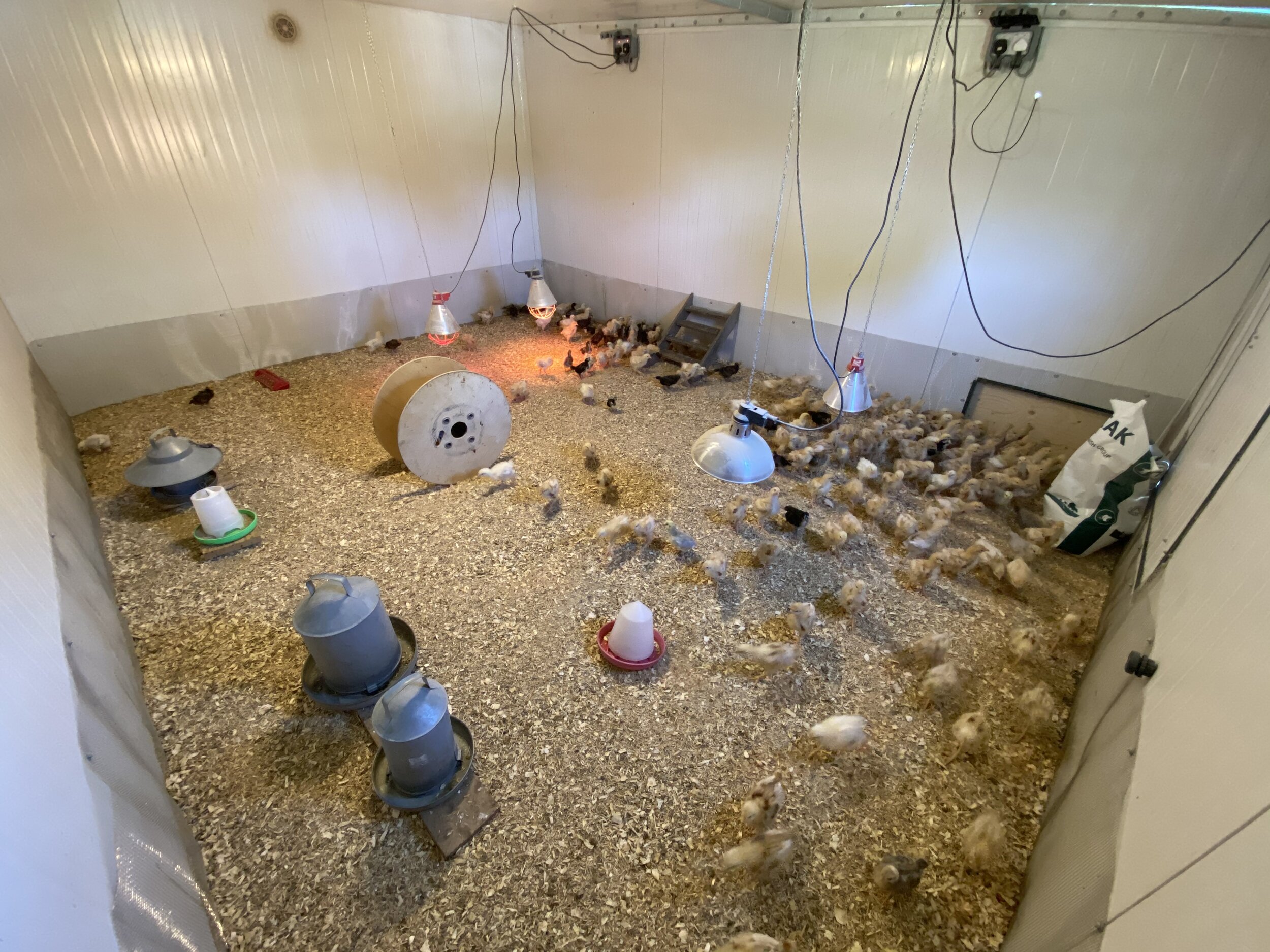
The inside of our brooding run.

Our brooding run.
Due to the Coronavirus pandemic, we haven’t had our first visit from the Soil Association, but we can’t wait for them to come and see how we keep the hens happy! If you’d like more information on what it takes to become organic, just send us an email and we’d be happy to chat to you about our journey.
Picking the correct breed for you and your family is vital. It can be the difference between you and your chickens flourishing together or you regretting the day you brought them home!
Firstly you need to think about why you’re choosing to have chickens in the first place. Is your aim just to have fresh, tasty eggs daily and to keep your chickens as pets? Do you want to raise the birds to become part of the dinner table? Or are you looking at conserving a rare breed?
There are specific chickens that are really reliable egg layers, like Rhode Island Reds and Leghorns, which lay a high amount of eggs. Whereas other breeds such as broilers are much better for meat, but won’t lay you many eggs!
Secondly, you need to think about how much time you want to spend with your chickens. Some variety of chickens can be very high maintenance and require a lot of time from you. Whereas a lot of other breeds are pretty self sufficient and won’t require much time from you at all.
Thirdly, you need to think about the climate where you are. Make sure that the breed you choose is suitable to your area. Most breeds seem to cope in all climates, if you’re buying your chickens locally, then they are probably already suited to your climate. If you’re buying them from further a-field, just check with the supplier that they will be suited to your area/region.
The fourth thing you need to think about is the amount of space that you have to give your chickens. Some breeds require more space than others and if they don’t get that space, they can sometimes turn violent toward each other!
If you’ve got any questions about any of our breeds and you’d like to know if they’d be a good fit for you, please don’t hesitate to contact us! info@higheroakfarm.co.uk
Have a look at a recent blog post on keeping chickens for beginners.
